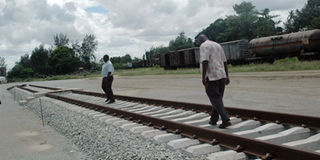Train back on track as probe clears rail project

PHOTO | FILE A section of the standard gauge railway that was opened by president Uhuru Kenyatta in Changamwe in this picture taken on 10 April 2014.
What you need to know:
- Among a raft of proposals, the PIC recommends that the Government fast-tracks Phase II of the project, so as to achieve the “maximum viable economic potential in the region.”
- By putting closure to its probe, the PIC has brought to a positive end the twin parallel investigations that were instituted by Parliament into the SGR project.
- The next threshold in the project timeline should be the signing of the commercial contracts with the proposed financiers, Exim Bank of China.
On the last day of April, 2014, the chairman of the parliamentary Public Investments Committee Adan Keynan tabled an important report in the August House.
The 82-pager is the result of several months of investigation by the committee into the “procurement and financing of the construction of the standard gauge railway project” from Mombasa to Nairobi.
“...The project should therefore proceed, taking into consideration the observations and recommendations by the Committee and review of the project to ensure value for money since, as of now, there are no contractual/financing obligations on the part of Government until a financing agreement is signed,” the PIC report concludes.
It reiterates the fact that the SGR is a key flagship project under Kenya’s Vision 2030 economic blueprint, and is “critical for the economic development of Kenya and East Africa.”
Among a raft of proposals, the PIC recommends that the Government fast-tracks Phase II of the project, so as to achieve the “maximum viable economic potential in the region.” This is in reference to the second leg of the project, which constitutes the construction of an SGR line linking Nairobi to the border town of Malaba, with a branch to the lakeside city of Kisumu.
The Committee calls for the strengthening of the legal provisions for the Railway Development Fund, the special kitty introduced to finance the project, and a review of the Public Procurement and Disposal Act of 2005 to align it with the Constitution and emerging trends in public buying.
By putting closure to its probe, the PIC has brought to a positive end the twin parallel investigations that were instituted by Parliament into the SGR project.
The other, which was executed by the Parliamentary Committee on Transport, Public Works and Housing, under the chairmanship of Starehe MP Maina Kamanda, concluded its work in February this year, delivering an identical “go ahead” verdict.
Government agencies working on the project, especially Kenya Railways as the implementing agency and the Ministry of Transport and Infrastructure as the policy think-tank, have every reason to feel vindicated by the PIC’s verdict, and that of the Transport Committee before it.
Interestingly, the conclusions by the Adan Keynan-led PIC are largely aligned with what the Government has held all along.
That critics of the project, who had earlier mounted a frenetic political campaign against it, had missed the train on the financial end of things. That the country had not lost any money since no binding commercial contracts had been signed between Kenya and the parties involved.
That the only document that was on the table was a memorandum of understanding (MoU) between Kenya and the relevant entities. But even the other arguments against the project by both elements within the political class and, lately, civil society, notably hinged on its commercial viability and technical soundness, have been wobbly, presumptive and devoid of foundation.
The clean bill of health by the two key oversight bodies in Parliament gives the SGR much-needed socio-political sanction and momentum. With these intellectual and moral hurdles successfully surmounted, the project can now move seamlessly into executing its mandate of improving cargo and passenger transport in Kenya, while improving the country’s overall competitiveness as an investment destination key deliverables for the Government.
These benefits shall also accrue to the huge swathe of eastern and Central Africa, called the Northern Corridor, which looks up to the port of Mombasa as their gateway to the world.
Most significantly, the SGR project is the child of a trilateral regional initiative that originally brought together Kenya, Uganda and Rwanda, with the aim of linking Mombasa to Kampala and onward to Kigali.
South Sudan has since come on board, with the result that a line between Kampala and Juba is now an integral part of the landmark and game-changing venture.
NO FURTHER DELAYS
The next threshold in the project timeline should be the signing of the commercial contracts with the proposed financiers, Exim Bank of China. With the current trend of regular contact between Kenya and China at the highest levels, it is largely expected that the project will now proceed with no further delays or speck of doubt.
Already, the mobilisation of the contractor, China Road and Bridge Corporation, is ongoing. Of course, it helps that the firm already has an active presence in the country and the necessary institutional memory when it comes to infrastructural building, with an expansive project portfolio to match its experience.
The SGR is a project that Kenya needs to have commissioned yesterday and the sooner it is delivered, the better for the country’s economy and that of the Northern Corridor as a whole.
The author works in Communications and Media Affairs for the standard gauge railway project




